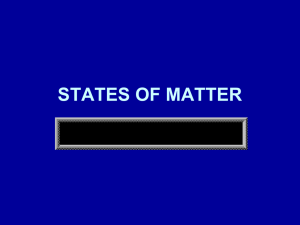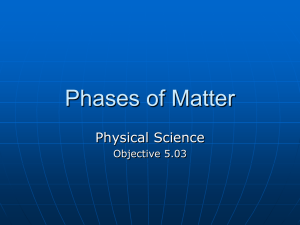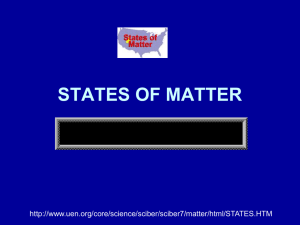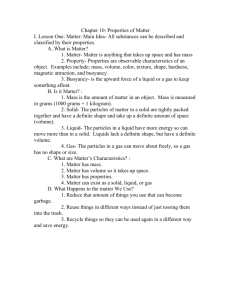IPC Review - Solids Liquids and Gases
advertisement
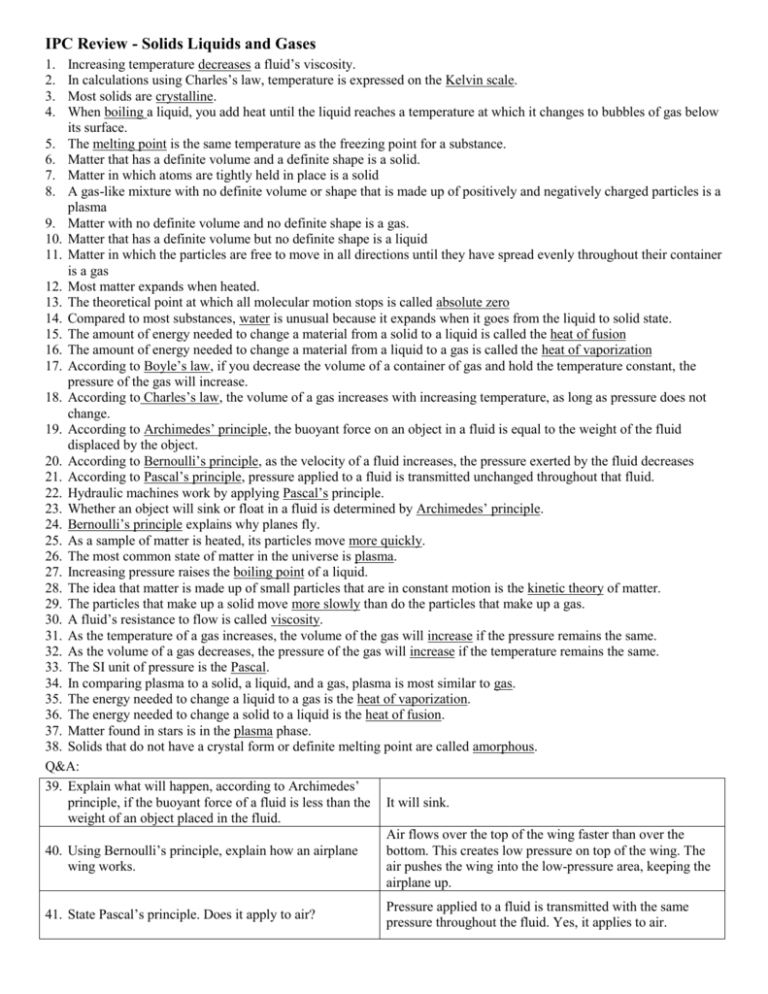
IPC Review - Solids Liquids and Gases Increasing temperature decreases a fluid’s viscosity. In calculations using Charles’s law, temperature is expressed on the Kelvin scale. Most solids are crystalline. When boiling a liquid, you add heat until the liquid reaches a temperature at which it changes to bubbles of gas below its surface. 5. The melting point is the same temperature as the freezing point for a substance. 6. Matter that has a definite volume and a definite shape is a solid. 7. Matter in which atoms are tightly held in place is a solid 8. A gas-like mixture with no definite volume or shape that is made up of positively and negatively charged particles is a plasma 9. Matter with no definite volume and no definite shape is a gas. 10. Matter that has a definite volume but no definite shape is a liquid 11. Matter in which the particles are free to move in all directions until they have spread evenly throughout their container is a gas 12. Most matter expands when heated. 13. The theoretical point at which all molecular motion stops is called absolute zero 14. Compared to most substances, water is unusual because it expands when it goes from the liquid to solid state. 15. The amount of energy needed to change a material from a solid to a liquid is called the heat of fusion 16. The amount of energy needed to change a material from a liquid to a gas is called the heat of vaporization 17. According to Boyle’s law, if you decrease the volume of a container of gas and hold the temperature constant, the pressure of the gas will increase. 18. According to Charles’s law, the volume of a gas increases with increasing temperature, as long as pressure does not change. 19. According to Archimedes’ principle, the buoyant force on an object in a fluid is equal to the weight of the fluid displaced by the object. 20. According to Bernoulli’s principle, as the velocity of a fluid increases, the pressure exerted by the fluid decreases 21. According to Pascal’s principle, pressure applied to a fluid is transmitted unchanged throughout that fluid. 22. Hydraulic machines work by applying Pascal’s principle. 23. Whether an object will sink or float in a fluid is determined by Archimedes’ principle. 24. Bernoulli’s principle explains why planes fly. 25. As a sample of matter is heated, its particles move more quickly. 26. The most common state of matter in the universe is plasma. 27. Increasing pressure raises the boiling point of a liquid. 28. The idea that matter is made up of small particles that are in constant motion is the kinetic theory of matter. 29. The particles that make up a solid move more slowly than do the particles that make up a gas. 30. A fluid’s resistance to flow is called viscosity. 31. As the temperature of a gas increases, the volume of the gas will increase if the pressure remains the same. 32. As the volume of a gas decreases, the pressure of the gas will increase if the temperature remains the same. 33. The SI unit of pressure is the Pascal. 34. In comparing plasma to a solid, a liquid, and a gas, plasma is most similar to gas. 35. The energy needed to change a liquid to a gas is the heat of vaporization. 36. The energy needed to change a solid to a liquid is the heat of fusion. 37. Matter found in stars is in the plasma phase. 38. Solids that do not have a crystal form or definite melting point are called amorphous. Q&A: 39. Explain what will happen, according to Archimedes’ principle, if the buoyant force of a fluid is less than the It will sink. weight of an object placed in the fluid. Air flows over the top of the wing faster than over the 40. Using Bernoulli’s principle, explain how an airplane bottom. This creates low pressure on top of the wing. The wing works. air pushes the wing into the low-pressure area, keeping the airplane up. 1. 2. 3. 4. 41. State Pascal’s principle. Does it apply to air? Pressure applied to a fluid is transmitted with the same pressure throughout the fluid. Yes, it applies to air. 42. Explain how a hot-air balloon works using Charles’s law and Archimedes’ principle. Charles’s law—as air is heated, it expands; Archimedes’ principle—as air expands, it becomes less dense than surrounding air, so the buoyant force becomes greater than the weight of the balloon, and it goes up 43. Some high-altitude balloons are only partially filled when they are released from the ground. Using Boyle’s law, explain why the balloons are only partially filled. Assume the air temperature remains constant. At higher altitude, there is less pressure. According to Boyle’s law, the volume of the gas will increase and the balloon fills up completely. 44. State Boyle’s law. Does it apply to water vapor? Decrease the volume of a gas and the pressure of the gas will increase, assuming constant temperature. Yes, it applies to water vapor. 45. Adding thermal energy to a solid normally causes a temperature change in the solid. What happens to the thermal energy and the temperature as the solid melts? 46. Thermal energy is added to water to turn it into steam. Explain this event according to the kinetic theory of matter. 47. A cold glass will collect moisture on a hot, humid day. Explain this event according to the kinetic theory of matter. 48. Which of the states of matter can you force into a smaller volume? Explain. 49. Explain the thermal expansion of a solid using the kinetic theory of matter. 50. Explain what happens at the surface of a liquid according to the kinetic theory as thermal energy is added to the liquid. 51. Explain the purpose of an expansion joint on a bridge. 52. What are the melting point and boiling point of water on the Kelvin temperature scale? 53. Will more or less of a large ship be above the water in a narrow river compared to the open ocean? 54. What will happen to the size of a balloon when it is placed in a freezer? Explain. 55. List the states of matter and explain their differences using the kinetic theory of matter. 56. High-speed military aircraft sometimes have small, white clouds form on the trailing edge of their wings during high-speed turns. Explain this in terms of Bernoulli’s principle and condensation. 57. What strange property of water does a glass of ice water illustrate? temperature remains the same; thermal energy goes to breaking solid particles apart Water molecules are moving but are held together; as thermal energy is added, molecules move more quickly and are not held as tightly, and some fly off as steam. Water vapor in air transfers thermal energy to the cooler glass. This slows the molecules, and condensation occurs. Gas and plasma; there is still room between the particles. As thermal energy is added to the solid, the particles gain kinetic energy and move faster. The particles take up a little more room, but they are still held tightly. Liquid molecules are free to move and have a range of kinetic energies. They will gain kinetic energy from thermal energy, and some particles can fly off the surface if they have enough energy. As the bridge heats in the summer, it becomes longer; in the winter, it becomes shorter. An expansion joint allows the bridge to be fixed at one end and allows the other end to move with temperature changes. K= °C +273.16. So the melting point is O°C +273.16 = 273.16 K, and the boiling point is 100 °C + 273.16 = 373.16 K. Neither, it will float just as high. Its height above water depends only on the amount of water displaced, not the amount of water the ship is in. It shrinks; as the temperature of air decreases, the volume of the air decreases. solid—particles held tightly, not free to move around; liquid—particles very close together but free to move; gas—particles are free to move in any direction, not held together; plasma—particles move with so much energy they break into smaller charged particles. During high-speed turns, air moving over the top of the wing goes even faster. This causes a lower-pressure area, and sudden low pressure causes moisture in the air to condense, forming a cloud. When the air slows down, pressure goes up and air temperature rises, so no condensation appears. This illustrates the expansion of water as it goes from a liquid to a solid. Because solid water (ice) is less dense than liquid water, it floats. 16,170 N 5005 cm2 = x ; x = (65)(16,170) = 210 N 65 cm2 5005 Figure 16-1 58. Use Figure 16-1 to solve the following problem. A car with a weight of 16,170 N is placed on piston B of a hydraulic lift. Piston B has a surface area of 5,005 cm2, and piston A has an area of 65 cm2. What force must be applied to piston A to lift the car? Figure 16-2 59. The dots on the balloon in Figure 16-2 represent particles of air. Use what you know about pressure, temperature, volume, and the kinetic theory of matter to write a hypothesis to explain what will happen to the volume of the balloon if pressure is kept constant and the temperature is lowered. 60. A 210-N force is applied to the top of a piston, and the force produces 320 kPa of pressure. What is the area of the piston? The movement of the particles inside the balloon will slow down. Because the pressure is the same, the number of collisions of the particles and the balloon is the same. As a result, the volume of the balloon decreases. 1 Pa = 1.0 N/m2; 1kPa = 1000 Pa; 210 N . …………………………………..320,000 N/m2 ………………………………......= 0.00066 m2 Steps: a. Ice temperature is raised from ‒20oC to 0 oC. Still solid. b. Changes phase from to solid to liquid. No temperature change. c. Liquid water temperature is raised from 0 oC to 100 oC. Still liquid. d. Changes phases from liquid to gas. No temperature change. 61.


